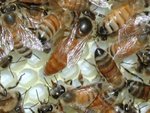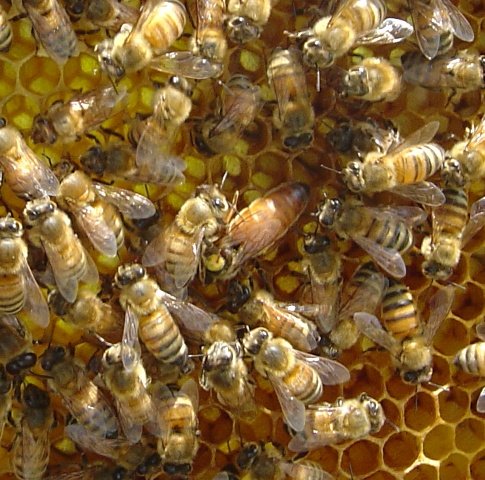.
 .
..
Left: The mating yard offered to me by two fellow beekeepers, Paul and Claire.
.
.
.
.
.
.
With much anticipation I opened the first mating nuc, and pulled out the queen cell and queen cell protector. It had emerged!
My next step was to inspected the two frames of bees in the mating nuc to see if the queen had successfully bee accepted as part of the hive.
In order for her to have been successful she would have to have completed the following.
.
 .
..
Right: Opening the first two frame nuc to see if the queen had emerged from her cell. You can see the plastic cell protector resting between the two frames of bees.
.
.
.
1. Successfully emerge from the queen cell.
2. Be accepted by the bees as leader of the hive
3. Conduct two to three mating flights where she would have to successfully mate with up to 15 male bees (drones)
4. Finder her way back to the hive without being lost or eaten by a bird
5. Start to lay fertilized (female) eggs.
Sure enough I found her on the first frame I checked. Could she have begun to lay eggs? Sure enough she was on a frame containing eggs and very young larva. Success!
.
.
 .
..
Right: An unmarked mated queen was found in the first mating nuc. 6 mated queens were produced from my second grafting attempt.
.
.
.
.
.
Needless to say I was pleased.
I had brought yellow paint (the marking color for 2007) so I could mark any queens I found, but as I attempted to pick her up to mark her back (Thorax) with the paint, she flew away onto a bush. I rushed over and tried to pick her up, but she flew out of my hand into the grass. I quickly went to grasp her but she flew into the dirt, I went over and picked her up, and she flew away into the cranberry bog.
I was not pleased.
Would she return? Was she lost forever?
Sure enough after a few minutes she returned, and I was able to mark her. I guess she was not about to go through all that work only to have me mess it up.
.
 .
..
Right: A marked queen. The newly produced queens are marked in yellow. Yellow is the standard queen marking color for 2007.
.
.
.
I continued to check the other mating nucs. Out of 9 queen cells 6 hatched and mated successfully. One of the mating nucs had an empty queen cell, but no bees or queen were found inside.
Perhaps they did not like their new home and decided to find a new place to live.
Of the 7 queens, 6 are large healthy looking queens. One however is on the smaller size.
Here is the summery of the July 1, 2007 grafting attempt
.
 .
..
Left: A closeup of the marked mated queen.
.
.
.
.
.
.
.
.
.
.
.
July 1: >90 grafts are made into plastic queen cups.
The queen cups are placed in a queen cup frame and placed into a cell builder
hive
July 3: >Queen cups are inspected. 10 cells have been started from the grafts.
July 15: >8 cells are introduced into two frame mating nucs containing bees. Two cells are
destroyed. One accidentally when removing it from the cell cup frame, the other
is dissected to see if the queens are developing
July 22: >7 queens successfully emerge, mate, and start producing.
destroyed. One accidentally when removing it from the cell cup frame, the other
is dissected to see if the queens are developing
July 22: >7 queens successfully emerge, mate, and start producing.
.
.
Right: Activity outside the mating nucs. Four, two frame mating nucs are contained in one standard deep super. Each two frame nuc has a seporate entrance.
.
.
.
.
.
.
.
.
Now we will watch and evaluate them. Over the next two months they will show their true colors.
.
I will be looking for a nice brood pattern (laying pattern), and a quiet disposition from her offspring.









You made me laugh out loud at losing the queen. I'm glad it's not just me that sort of thing happens to.
ReplyDelete